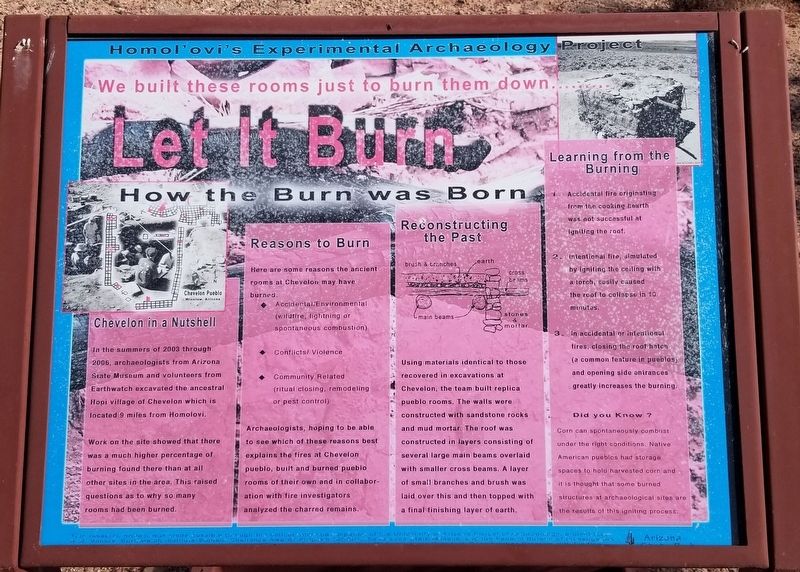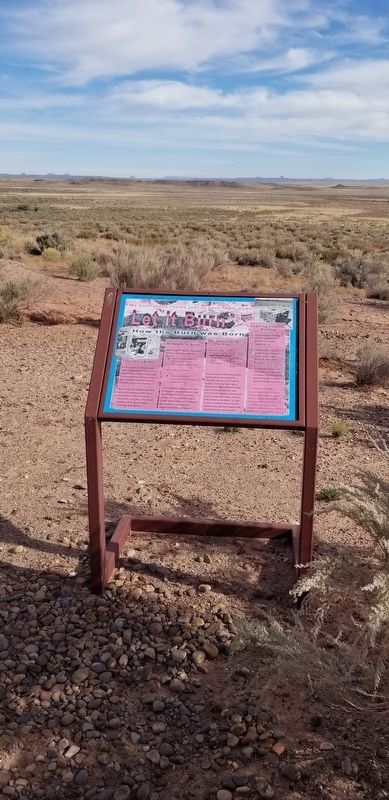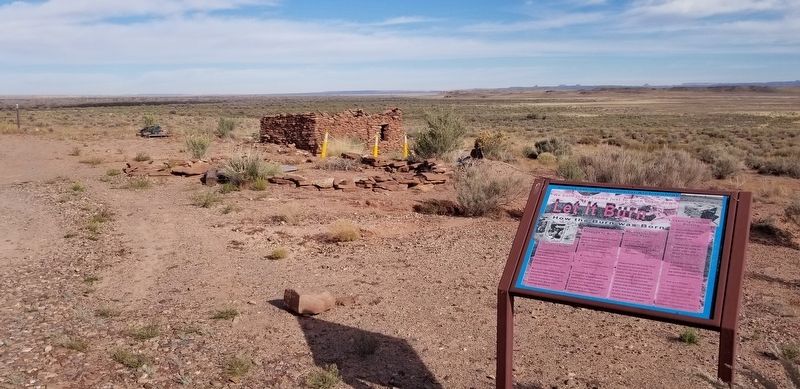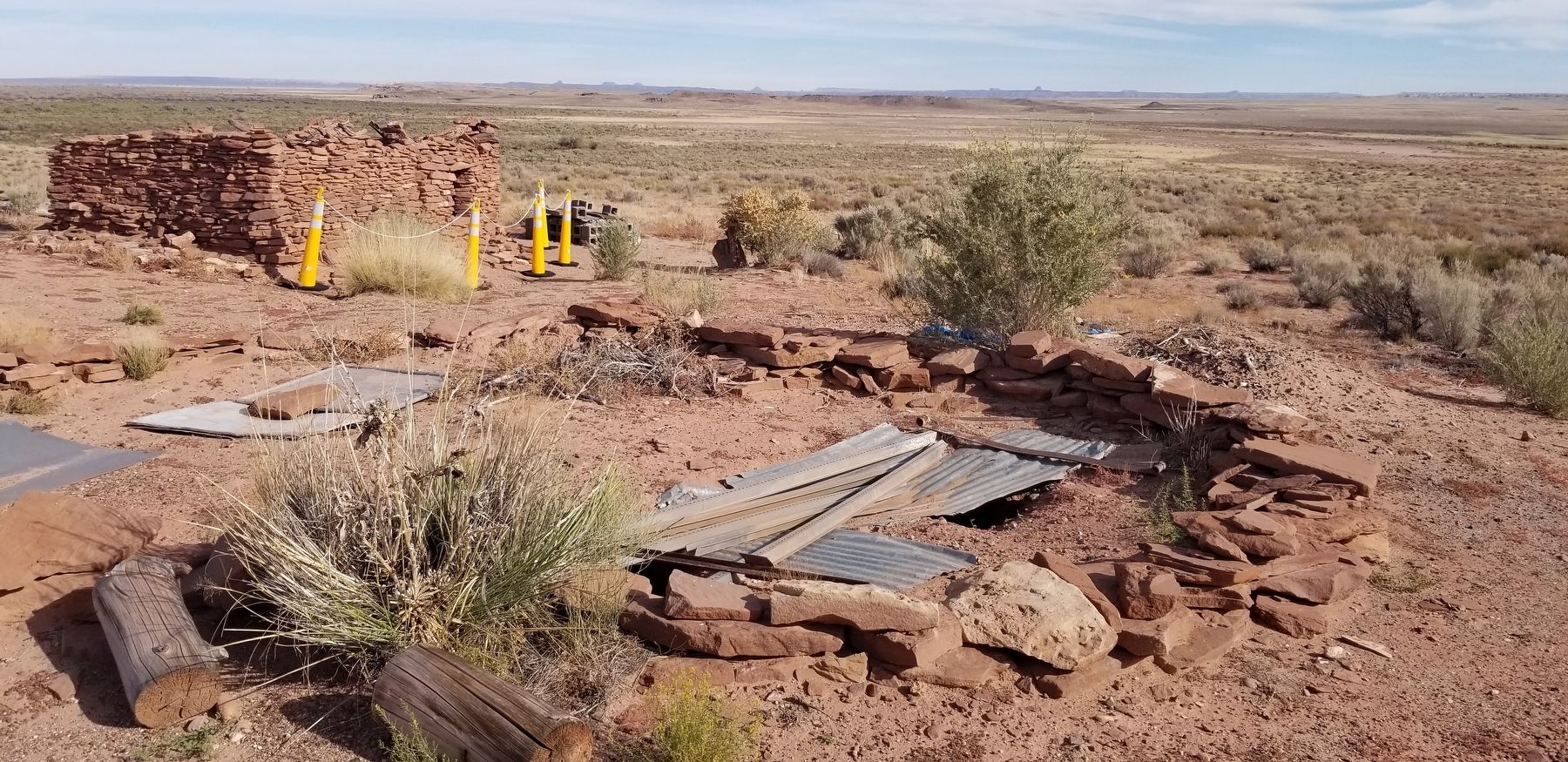Near Winslow in Navajo County, Arizona — The American Mountains (Southwest)
Let It Burn
We built these rooms just to burn them down
— Homol'ovi's Experimental Archaeology —
Chevelon in a Nutshell
In the summers of 2003 through 2006, archaeologists from Arizona State Museum and volunteers from Earthwatch excavated the ancestral Hopi village of Chevelon which is located 9 miles from Homolovi.
Work on the site showed that there was a much higher percentage of burning found there than at all other sites in the area. This raised questions as to why so many rooms had been burned.
Reasons to Burn
Here are some reasons the ancient rooms at Chevelon may have burned:
• Accidental Environmental (wildfire, lightning or spontaneous combustion)
• Conflicts/ Violence
• Community Related (ritual closing, remodeling or pest control)
Archaeologists, hoping to be able to see which of these reasons best explains the fires at Chevelon pueblo, built and burned pueblo rooms of their own and in collaboration with fire investigators analyzed the charred remains.
Reconstructing the Past
Using materials identical to those recovered in excavations at Chevelon, the team built replica pueblo rooms. The walls were constructed with sandstone rocks and mud mortar. The roof was constructed in layers consisting of several large main beams overlaid with smaller cross beams. A layer of small branches and brush was laid over this and then topped with a final finishing layer of earth.
Learning from the Burning
1. Accidental fire originating from the cooking hearth was not successful at igniting the roof.
2. Intentional fire, simulated by igniting the ceiling with a torch, easily caused the roof to collapse in 10 minutes.
3. In accidental or intentional fires, closing the roof hatch (a common feature in pueblos) and opening side entrances greatly increases the burning.
Did you know ?
Corn can spontaneously combust under the right conditions. Native American pueblos had storage spaces to hold harvested corn and it is thought that some burned structures at archaeological sites are the results of this igniting process.
Erected by Homolovi State Park, Arizona State Museum and University of Arizona's School of Anthropology.
Topics. This historical marker is listed in these topic lists: Anthropology & Archaeology • Native Americans. A significant historical year for this entry is 2003.
Location. 35° 2.818′ N, 110° 39.192′ W. Marker is near Winslow, Arizona, in Navajo County. Marker can be reached from Homolovi State Park Entrance Road, 2.1 miles west of Arizona Route 87. The marker is located behind the Homolovi State Park Visitor Center and Gift Shop. Touch for map. Marker is in this post office area: Winslow AZ 86047, United States of America. Touch for directions.
Other nearby markers. At least 8 other markers are within 3 miles of this marker, measured as the crow flies. Mormon Pioneers Along the Little Colorado River (about 300 feet away, measured in a direct line); General Lot Smith (approx. 0.4 miles away); Sunset (approx. 0.4 miles away); Brigham City (approx. 1.8 miles away); Remembrance Garden (approx. 2.6 miles away); The Winslow Bridge (approx. 2.6 miles away); Typical Room (approx. 2.7 miles away); Sunset Crossing (approx. 2.7 miles away). Touch for a list and map of all markers in Winslow.
Also see . . . Experimental archaeology.
Experimental archaeology (also called experiment archaeology) is a field of study which attempts to generate and test archaeological hypotheses, usually by replicating or approximating the feasibility of ancient cultures performing various tasks or feats. It employs a number of methods, techniques, analyses, and approaches, based upon archaeological source material such as ancient structures or artifacts. Source: Wikipedia(Submitted on November 6, 2021, by James Hulse of Medina, Texas.)
Credits. This page was last revised on November 7, 2021. It was originally submitted on November 6, 2021, by James Hulse of Medina, Texas. This page has been viewed 324 times since then and 13 times this year. Photos: 1, 2. submitted on November 6, 2021, by James Hulse of Medina, Texas. 3, 4. submitted on November 7, 2021, by James Hulse of Medina, Texas.



